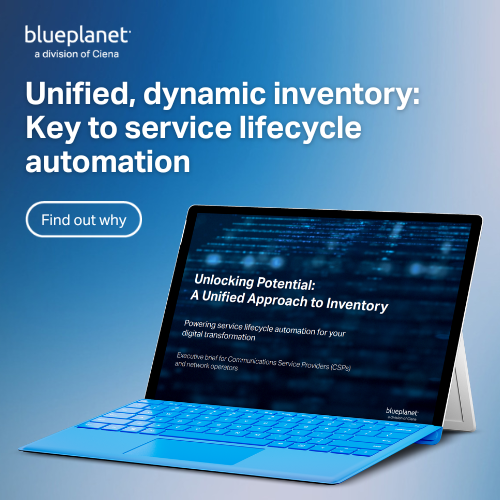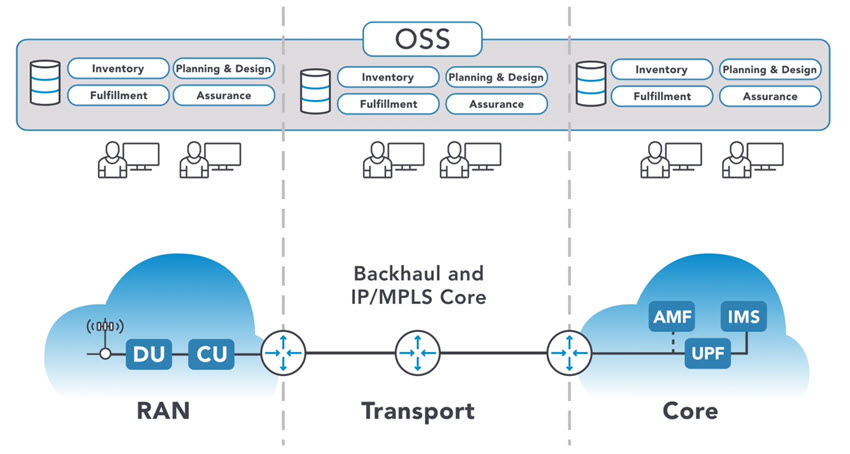Dynamic inventory lays the foundation for 5G
For CSPs, turning their 5G vision into reality is dependent on fast and profitable service delivery. Achieving this demands an accurate inventory of all their physical and cloud-based resources distributed across multiple domains.
Blue Planet’s Kailem Anderson details the importance of dynamic inventory management, and how one major CSP is already implementing this approach in their 5G network today.
The journey to 5G and modernization of Operations Support Systems (OSS) go hand in hand, and for a growing number of our customers, it begins by gaining complete visibility into their network and services inventory. In fact, Communications Service Providers (CSPs) that don’t have end-to-end visibility of dynamic services are going to have a hard time delivering on their 5G visions.
For CSPs, turning their 5G vision into reality is dependent on fast and profitable service delivery. Achieving this demands an accurate inventory of all their physical and cloud-based resources distributed across multiple domains. Take 5G network slicing as an example. If you want to plan and deliver an end-to-end slice for an online gaming service in a specific location, you need near real-time access to inventory data about all the related network and service resources spread across the radio access network (RAN), transport, core, and cloud domains.
This dynamic inventory management capability is a critical component in CSPs’ ability to successfully plan, deploy and manage their 5G services. Comprehensive and clean inventory provides the foundation for OSS modernization and is ultimately necessary to automate 5G network and service operations.
The dilemma for most operators, however, is that their legacy inventory systems were designed to operate in domain silos. This limits their ability to intelligently plan and deploy new infrastructure, and automate operations because network design and operations teams typically have to manually correlate network inventory data by “swivel-chairing” between multiple systems in each domain. As a result, end-to-end service creation and activation is excruciatingly slow and error-prone, resulting in the inability to support dynamic services like network slicing.
Figure 1. Siloed inventory approach doesn’t support 5G end-to-end visibility
Evolving to unified inventory
So, what’s the solution for CSPs operating 5G networks with legacy inventory systems? Many believe that unified and dynamic inventory management is only possible by creating a customized inventory system with an existing vendor, or by developing a new homegrown solution. Both are time-consuming, expensive endeavors. But what if you could modernize your inventory without ongoing and costly customizations?
That’s where Blue Planet Inventory (BPI) can help. BPI offers a modern, cloud-native approach to inventory management that uses robust and flexible federation technology and an advanced graph database to combine inventory data that resides in disparate systems to deliver an accurate and dynamic view of network resources as well as the end-to-end services topology. BPI uses standard APIs to create an abstraction layer across different data sources that are involved in managing services, such as legacy inventory systems and network management systems (NMS), as well as orchestrators and Software-Defined Network (SDN) controllers that are involved in delivering newer virtualized, on-demand services.
By extracting all that information into a unified, data model-driven service view, Blue Planet provides a “single source of truth” for your 5G network. This federated approach lets you streamline and simplify your operations, and modernize at your own pace while minimizing the risks associated with large transformation projects.
Streamlining ‘Day 0’ planning and ‘Day 1’ activation for 5G
A comprehensive view of existing physical, logical, and virtual resources is needed to efficiently plan the deployment of new infrastructure like cell sites, fiber nodes, and edge cloud capabilities, as well as to manage capacity. Unique to 5G is the need to plan and place Distributed Units, or DUs, that control the Radio Units, as well as other virtualized and cloud-native network functions that might comprise a network slice. Blue Planet Inventory allows you to model capacity inside a data center in support of these design decisions. The ability to visualize the optimal placement of physical and cloud-native resources as well as the end-to-end 5G service topology helps CSPs plan and deploy their 5G resources quickly and efficiently. This simplified “Day 0” planning is an essential first step toward optimizing network capacity and accelerating your 5G deployments.
Figure 2. Blue Planet dynamic inventory simplifies and automates planning from cell site to core
Once deployed, Blue Planet also supports the ‘Day 1’ configuration and activation of the gNodeB (gNB), and of the transport elements that interconnect the gNB and 5G core. This labor-saving automation helps contain OPEX and reduces the burden on already strained IT teams; it also creates a strong foundation for automated slice lifecycle management – and for ongoing operational tasks, such as optimization and troubleshooting activities.
As CSPs implement 5G standalone core architectures, they will use network slicing to deliver a wide range of new 5G services. Orchestrating these slices demands an accurate inventory of available resources, which BPI can provide to multi-domain slice orchestrators to permit automated end-to-end slice activation and modification. When slices are deactivated, their associated resources are dynamically released back to BPI for future re-use, which helps contain CAPEX by maximizing resource utilization.
Dynamic inventory in action at Boost Mobile (formerly DISH Wireless)
Boost Mobile's greenfield cloud-native 5G network shows what’s possible with dynamic inventory. In a recent blog, I explained how the company is using BPI to federate discovered RAN resources with data it gathers from other systems, creating a single source of truth for the network.
"Blue Planet is a key component of our 5G platform, allowing us to dynamically manage all our network inventory and service orders in real time,"
- Marc Rouanne, VP and Chief Network Officer at Boost Mobile
Importantly, BPI lets Boost Mobile bypass a traditional approach to network architecture that relies on asking network engineers to physically update network inventory and instead keeps the Boost Mobile 5G network updated in near real-time, providing a consistent, end-to-end view through a single pane of glass.
This is allowing Boost Mobile to extend automation to its own customers. The idea is to help enterprises shift from a highly linear and physical process of negotiating services to a more flexible cloud-native environment where they can model new services and create them on the fly.
Eventually, Boost Mobile expects to deliver tens of thousands of 5G network slices on demand, according to Marc Rouanne, VP and Chief Network Officer at Boost Mobile. “Blue Planet is a key component of our 5G platform, allowing us to dynamically manage all our network inventory and service orders in real-time,” he says. “With Blue Planet’s open, agile, and programmable approach, DISH can rapidly deploy services and allocate resources to wholesale and enterprise customers, enabling them to provision network slices based on SLAs.”
The bottom line
Supporting dynamic networks and services, like 5G, requires a complete and accurate view of your network. Only Blue Planet gives you the full picture of your network and services resources across hybrid radio access, core, and edge cloud domains – in a single pane of glass.
Contact us to learn more about how Blue Planet can help.



